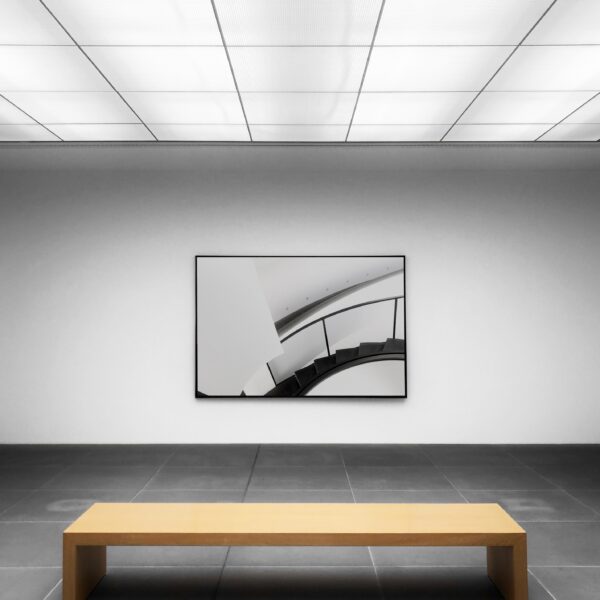
How to print and display monochrome pictures
Powerful? Tick. Nostalgic? Tick. Timeless? Tick! Black-and-white pictures have a remarkable ability to make a vivid statement, even in the absence of colour. This monochromatic medium allows artists and photographers to tap into the essence of their subjects, unearthing a raw narrative that can deeply resonate with viewers.
Whether you are a seasoned photographer seeking to showcase your portfolio or someone looking to decorate your walls with the enduring charm of black-and-white art, this guide will tell you everything you need to know about printing and displaying monochrome pictures.
1. Select a high-quality image
When it comes to selecting black-and-white pictures for printing, there are several factors to consider in order to ensure a compelling result.
One important aspect to keep in mind is your choice of subject matter. Certain textures, particularly those found in natural materials such as stone, metal, and wood, translate beautifully in black-and-white prints. These materials have inherent visual interest and can add depth and character to your monochrome images, so consider selecting pictures that showcase these textures to create an engaging piece.
Another crucial factor to consider is ‘tonal contrast’ — the difference in brightness or darkness within an image. Look for photos that have a wide range of tones, from deep blacks to bright whites, and search for intriguing shadows and eye-catching highlights that could make your print impactful.
Remember that this is a subjective process. Explore different subjects, compositions, and tonal ranges to find images that resonate with you personally and evoke an emotional response.
2. Pick the right print medium
Paying attention to paper type is paramount when it comes to printing in black-and-white, yet it is an aspect that’s often overlooked. Even with pixel-perfect photos, using the wrong paper type or weight can negatively impact the final outcome of the product.
We highly recommend opting for a glossy, textured finish when it comes to printing in monochrome. This finish offers a multitude of advantages, including a surface that brings out deeper blacks, enhances shadow detail, and highlights brighter areas. For those seeking a different aesthetic, a matt finish is also a good option. Matt finishes lack the glossy sheen, which contributes to an understated and elegant look, adding subtlety to the monochrome composition.
To ensure you achieve the desired result, we recommend conducting a test print using two paper types: Hahnemuhle Baryta for glossy prints and photo rag for matt prints. Additionally, you should select a weight between 275-300+ GSM (grams per square metre), although the ideal weight depends on the specific paper type you are using.
SohoFrames provides a wide range of carefully chosen and specialised materials for our professional art printing services. These materials include canvas, digital fine art paper, and the archival PermaJet photographic paper. As part of our service, our team of London picture framers will take the time to guide you through the unique qualities of each material, offering recommendations and assisting you in making an informed choice.
3. Choose a complementary frame
If framing black-and-white photography, there are a few options that can complement and enhance the sophisticated monochrome aesthetic.
Pencil thin black frames are a timeless option that suits black-and-white photography well. Black frames create a strong contrast against the white borders of the photograph, enhancing the visual impact, while keeping the borders narrow allows the focus to remain on the images within.
On the flip side, going for white or off-white frames can create a subtle and cohesive look for black-and-white photography. It maintains a minimalist and modern feel while providing a clean border that complements the monochrome tones of the image.
Alternatively, aluminium frames can add a touch of modernity to black-and-white prints. The reflective quality of these frames bring out the highlights in the photograph, accentuating the contrast and adding depth to the presentation.
4. Display accordingly
When displaying monochrome prints, a gallery-style grid wall can create a striking visual impact. The beauty of the grid method lies in its versatility, as black-and-white prints can suit any style of home interior design, whether it’s a cosy flat, country cottage, or sprawling city penthouse. Alternatively, for a more relaxed and eclectic atmosphere, you can opt for an asymmetrical arrangement, which brings a playful touch.
A large, singular monochrome print can also produce a captivating focal point — a visually prominent feature that draws the eye and creates a sense of focus within a design. It’s the element that instantly captures your gaze and holds it, leaving a lasting impression. To create a focal point using a monochrome print, it’s all about the placement of the print within the room. Ideally, you should position it in an area where it can easily catch the viewer’s eye. This could be a central stairwell, above a fireplace, or any well-lit area that naturally draws attention.
If you’d like to learn more about our art printing services, or book in for a consultation with one of our bespoke picture framers, please don’t hesitate to get in touch with us today.

